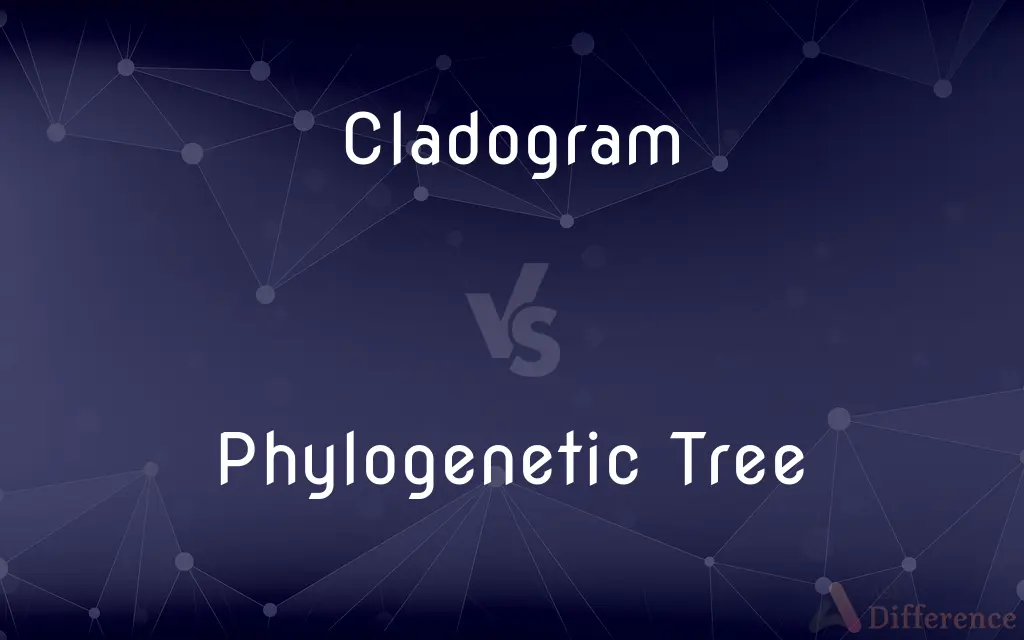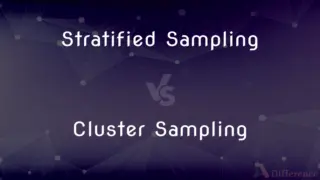Cladogram vs. Phylogenetic Tree — What's the Difference?
Edited by Tayyaba Rehman — By Fiza Rafique — Published on December 11, 2023
A Cladogram displays groupings based on shared features, without implying ancestry, while a Phylogenetic Tree shows evolutionary relationships and often includes time or branch length data.

Difference Between Cladogram and Phylogenetic Tree
Table of Contents
ADVERTISEMENT
Key Differences
Cladogram and Phylogenetic Tree both serve as valuable tools in the realm of evolutionary biology, helping to depict relationships between species or groups. A Cladogram, specifically, is a tree-shaped diagram that clusters organisms based on shared derived features. However, unlike the Phylogenetic Tree, the Cladogram's branching doesn't offer specifics on the timeline of evolutionary change or the degree of relatedness.
On the flip side, a Phylogenetic Tree delves deeper, tracing the evolutionary lineage of different species. Unlike a Cladogram, this tree often incorporates temporal information, revealing when certain divergences might have occurred. Additionally, branch lengths in a Phylogenetic Tree can signify the amount of evolutionary change or time, offering insights into the depth of relationships between the species.
For a newcomer, discerning between a Cladogram and Phylogenetic Tree might appear challenging. Both tools divide species into branches, indicating shared ancestry or traits. Yet, a keen eye would observe that while a Cladogram simply groups species based on certain shared characteristics, a Phylogenetic Tree delves into the evolutionary journey, charting out possible ancestral relationships and, in many cases, the timeline of these evolutionary shifts.
Visual representations are pivotal in evolutionary biology, with both Cladogram and Phylogenetic Tree offering distinct lenses. While a Cladogram simplifies complexities, focusing on shared features, a Phylogenetic Tree invites deeper exploration, showcasing evolutionary pathways, relationships, and, often, the passage of time. Both, however, converge on the ultimate goal: understanding the intricate web of life's evolutionary history.
Comparison Chart
Purpose
Shows groupings based on shared features.
Depicts evolutionary relationships.
ADVERTISEMENT
Temporal Information
Typically lacks time-related data.
Often includes time or evolutionary change data.
Branch Length Indication
Does not convey evolutionary change or time.
Can indicate the amount of evolutionary change or time.
Derived Features
Focuses on shared derived characteristics.
Considers all evolutionary changes.
Ancestral Implication
Doesn't imply specific ancestry.
Directly shows ancestral relationships.
Compare with Definitions
Cladogram
A Cladogram is a diagram that groups organisms based on shared characteristics.
The Cladogram clearly showcased the shared traits between amphibians and reptiles.
Phylogenetic Tree
Phylogenetic Trees can incorporate branch lengths that depict evolutionary change or time.
Longer branches on the Phylogenetic Tree indicated significant evolutionary changes.
Cladogram
Cladograms are foundational in cladistics, the study of relationships based on shared features.
Using a Cladogram, researchers could visualize the shared attributes of various insects.
Phylogenetic Tree
Phylogenetic Trees often showcase ancestors and the divergence of descendant species.
The Phylogenetic Tree traced back to the common ancestor of birds and reptiles.
Cladogram
In a Cladogram, the sequence of branching doesn't represent the passage of time.
The Cladogram's branches grouped organisms without revealing when these groups diverged.
Phylogenetic Tree
A Phylogenetic Tree is a representation of the evolutionary relationships between organisms.
The Phylogenetic Tree of mammals provided insights into their evolutionary lineage.
Cladogram
Cladograms emphasize shared derived traits among species.
The Cladogram highlighted the common features among different bird species.
Phylogenetic Tree
Phylogenetic Trees are central in phylogenetics, the study of evolutionary relationships.
Using a Phylogenetic Tree, biologists unraveled the complex history of various fungi.
Cladogram
Cladograms represent relationships without incorporating time or evolutionary change.
By examining the Cladogram, we understood the shared features but not the evolutionary timeline.
Phylogenetic Tree
In a Phylogenetic Tree, the branching patterns and lengths can convey the passage of time.
Through the Phylogenetic Tree, we deduced when certain plant species diverged.
Cladogram
A branching, treelike diagram in which the endpoints of the branches represent individual species of organisms. It is used to illustrate phylogenetic relationships and to show points at which various species are presumed to have diverged from common ancestral forms.
Cladogram
(taxonomy) A branching treelike graphical representation of the phylogenetic relationships between organisms showing which taxa have branched from common ancestors.
Cladogram
(phylogenetics) A phylogenetic tree that is strictly the outcome of a cladistic analysis.
Cladogram
A tree diagram used to illustrate phylogenetic relationships
Common Curiosities
What is a Cladogram?
A Cladogram is a diagram that groups species based on shared derived characteristics.
Can a Cladogram indicate the amount of evolutionary change?
Typically, a Cladogram doesn't indicate the amount of evolutionary change or specific timelines.
Why use a Cladogram?
A Cladogram offers a simplified view of relationships based on shared features without delving into evolutionary timelines.
Can a Cladogram depict ancestral relationships?
A Cladogram groups based on shared features but doesn't necessarily imply specific ancestral relationships.
How does a Phylogenetic Tree differ from a Cladogram?
A Phylogenetic Tree showcases evolutionary relationships and often provides time or evolutionary change data, unlike a Cladogram.
How do you interpret branch lengths in a Phylogenetic Tree?
Branch lengths can represent the amount of evolutionary change or the passage of time since divergence.
Why might scientists prefer a Phylogenetic Tree over a Cladogram?
Scientists might prefer a Phylogenetic Tree when they want to understand evolutionary relationships with temporal context or the degree of relatedness.
Are Cladograms and Phylogenetic Trees used in the same fields of study?
Both are used in evolutionary biology, with Cladograms focused on cladistics and Phylogenetic Trees on phylogenetics.
Do Phylogenetic Trees always show time or branch lengths?
Not always, but many Phylogenetic Trees include branch lengths to indicate time or evolutionary change.
Is a Phylogenetic Tree more detailed than a Cladogram?
Often, a Phylogenetic Tree provides more detailed insights into evolutionary relationships, including time and degree of relatedness.
What's the importance of a Phylogenetic Tree in evolutionary studies?
Phylogenetic Trees help understand evolutionary histories, relationships, and the timing of divergence events.
How are the shared features in a Cladogram determined?
Shared features in a Cladogram are usually determined through morphological or genetic data.
What does a node in a Cladogram represent?
In a Cladogram, a node typically indicates a point where a lineage splits based on shared features.
Can both Cladogram and Phylogenetic Tree be used to study ancient species?
Yes, both tools can be used to study relationships among ancient and modern species alike.
Are the branching patterns in a Cladogram and Phylogenetic Tree interpreted the same way?
Not always. In a Cladogram, the focus is on shared traits, whereas in a Phylogenetic Tree, the branching can indicate evolutionary change and time.
Share Your Discovery

Previous Comparison
Stratified Sampling vs. Cluster Sampling
Next Comparison
Hospital vs. Nursing HomeAuthor Spotlight
Written by
Fiza RafiqueFiza Rafique is a skilled content writer at AskDifference.com, where she meticulously refines and enhances written pieces. Drawing from her vast editorial expertise, Fiza ensures clarity, accuracy, and precision in every article. Passionate about language, she continually seeks to elevate the quality of content for readers worldwide.
Edited by
Tayyaba RehmanTayyaba Rehman is a distinguished writer, currently serving as a primary contributor to askdifference.com. As a researcher in semantics and etymology, Tayyaba's passion for the complexity of languages and their distinctions has found a perfect home on the platform. Tayyaba delves into the intricacies of language, distinguishing between commonly confused words and phrases, thereby providing clarity for readers worldwide.
















































